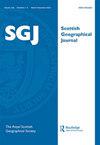苏格兰冰川涌动
IF 2
4区 社会学
Q2 GEOGRAPHY
引用次数: 9
摘要
冰川涌流是由内部动力不稳定性引起的速度和质量的循环振荡。对于激流型冰川,前进和后退的周期与气候强迫是分离的,因此在根据它们的尺寸和年表进行气候推断时,考虑以前的冰川可能是激流型的可能性是很重要的。在本文中,气候和冰川几何数据被用来表明苏格兰可能是洛蒙德湖时期(~ 12.9-11.7 ka)涌浪群的位置,西高地冰原的出口和内赫布里底群岛和北部高地的较大冰川的涌浪概率很高。所有这些地区都出现了与涌浪相一致的陆地和海洋地貌,并提出在北部高地的斯凯岛和马尔岛以及沿西高地冰原西部、南部和东南部边缘的“涌浪弧”中存在涌浪型冰川。在洛蒙德湖时期,激流型冰川在苏格兰广泛存在的可能性为一些长期存在的问题提供了新的视角,包括冰川消融类型与气候变化之间的关系、冰川年代学的气候意义、古气候重建以及数值模式结果的解释。本文章由计算机程序翻译,如有差异,请以英文原文为准。
Surging glaciers in Scotland
ABSTRACT Glacier surges are cyclic oscillations of velocity and mass resulting from internal dynamic instabilities. For surge-type glaciers, cycles of advance and retreat are decoupled from climate forcing, so it is important to consider the possibility that former glaciers may have been surge-type when making climatic inferences from their dimensions and chronologies. In this paper, climatic and glacier geometric data are used to show that Scotland was likely the location of a surge cluster during the Loch Lomond Stade (∼12.9–11.7 ka), with high probabilities of surging for outlets of the West Highland Icefield and the larger glaciers in the Inner Hebrides and Northern Highlands. Terrestrial and marine landforms consistent with surging occur in all of these areas, and it is proposed that surge-type glaciers existed on the Islands of Skye and Mull, in the Northern Highlands, and in a ‘surging arc’ along the western, southern and south-eastern margins of the West Highland Icefield. The possibility that surge-type glaciers were widespread in Scotland during the Loch Lomond Stade offers a fresh perspective on some long-standing issues, including the relationship between style of deglaciation and climate change, the climatic significance of glacial chronologies, palaeoclimatic reconstructions, and the interpretation of numerical model results.
求助全文
通过发布文献求助,成功后即可免费获取论文全文。
去求助
来源期刊

Scottish Geographical Journal
GEOGRAPHY-
CiteScore
1.80
自引率
20.00%
发文量
19
期刊介绍:
The Scottish Geographical Journal is the learned publication of the Royal Scottish Geographical Society and is a continuation of the Scottish Geographical Magazine, first published in 1885. The Journal was relaunched in its present format in 1999. The Journal is international in outlook and publishes scholarly articles of original research from any branch of geography and on any part of the world, while at the same time maintaining a distinctive interest in and concern with issues relating to Scotland. “The Scottish Geographical Journal mixes physical and human geography in a way that no other international journal does. It deploys a long heritage of geography in Scotland to address the most pressing issues of today."
 求助内容:
求助内容: 应助结果提醒方式:
应助结果提醒方式:


